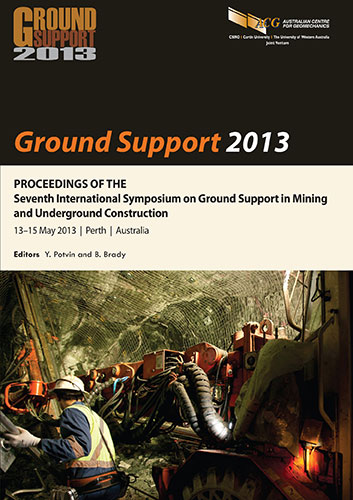Durability performance of bi-component polymer fibres under creep and in aggressive environments

|
Authors: Kaufmann, J; Manser, M Paper is not available for download Contact Us |
DOI https://doi.org/10.36487/ACG_rep/1304_40_Kaufmann
Cite As:
Kaufmann, J & Manser, M 2013, 'Durability performance of bi-component polymer fibres under creep and in aggressive environments', in Y Potvin & B Brady (eds), Ground Support 2013: Proceedings of the Seventh International Symposium on Ground Support in Mining and Underground Construction, Australian Centre for Geomechanics, Perth, pp. 585-596, https://doi.org/10.36487/ACG_rep/1304_40_Kaufmann
Abstract:
In tunnel and mining applications spraying of concrete is a well-established and economical alternative to conventional casting techniques. Further time and cost savings are achieved when fibre reinforced concrete is applied. Often steel fibres are used. Corrosion risk, damage of water impermeable films through the stiff fibres and a relatively high fibre rebound are some of the drawbacks of steel fibres. A suitable alternative may be found in polymer based fibres. Such fibres were thought to bear other problems regarding the long-term application. Especially their performance under permanent load (creep), but also their behaviour in aggressive environment, has been questioned. A recently developed polyolefin based bi-component fibre was investigated regarding its long-term behaviour. Pre-cracked fibre reinforced square panels were exposed to permanent load and different aqueous solutions (sodium chloride, sodium sulphate, sulphuric acid). Long-term deformation and residual load capacity were determined. In these laboratory tests it could be demonstrated that for this type of structured plastic fibre neither creep nor the exposure to aggressive underground environments seems to be a limiting factor.
References:
Bernard, E. (2004a) Creep of cracked fiber reinforced shotcrete panels, in Shotcrete: More Engineering Developments, Taylor and Francis, London, E.S. Bernard (ed), pp. 47–57.
Bernard, E. (2004b) Durability of cracked fibre reinforced shotcrete, in Shotcrete: More Engineering Developments, Taylor and Francis, London, E.S. Bernard (ed), pp. 59–66.
Clements, M. and Bernard, E. (2004) The use of macro-synthetic fiber reinforced shotcrete in Australia, in Shotcrete: More Engineering Developments, Taylor and Francis, London, E.S. Bernard (ed), pp. 20–22.
EFNARC (2000) European Federation of National Associations Representing producers and applicators of specialist building products for Concrete, European specification for Sprayed Concrete, viewed 25 January 2013, www.EFNARC.org.
Gossla, U. and Rieder, K-A. (2009) Time dependence of the behavior of macro polymer fiber reinforced concrete and its influence on the design of industrial floors, in German: Zeitabhängiges Verhalten von Makrokunststofffaserbeton und dessen Einfluss auf die Bemessung von Industriefussböden, Beton- und Stahlbetonbau Heft 2 (cement and concrete bulleton 2), pp. 76–87.
Hannant, D. (1998) Durability of polypropylene fibers in Portland cement-based composites: Eighteen years of data, Cement and Concrete Research, Vol. 28, No. 12, pp. 1809–1817.
Kaufmann, J., Lübben, J. and Schwitter, E. (2007) Mechanical reinforcement of concrete with bi-component fibers, Composites Part A: Applied Science and Manufacturing; Vol. 38, pp. 1975–1984.
Kurtz, S. and Balaguru, P. (2000) Postcrack creep of polymeric fiber-reinforced concrete in flexure, Cement and Concrete Research, Vol. 30 (2), pp. 183–190.
Maidl, B. (1992) Handbook of shotcrete – Handbuch für Spritzbeton, Berlin.
Nordström, E. (2005) Durability of sprayed concrete, doctoral thesis Luleå University of Technology, ISSN: 1402-1544.
Pang, J. and Xu, D. (2007) Support technology of polypropylene fiber concrete shotcrete layer and its application to Guqiao coal mine, Chinese Journal of Rock Mechanics and Engineering, Vol. 26(5), pp. 1073–1077.
Rose, D. (1985) Tunnel shotcreting – strength in fibers, Civil Engineering, New York, Vol. 55(12), pp. 62–63.
© Copyright 2025, Australian Centre for Geomechanics (ACG), The University of Western Australia. All rights reserved.
View copyright/legal information
Please direct any queries or error reports to repository-acg@uwa.edu.au
View copyright/legal information
Please direct any queries or error reports to repository-acg@uwa.edu.au